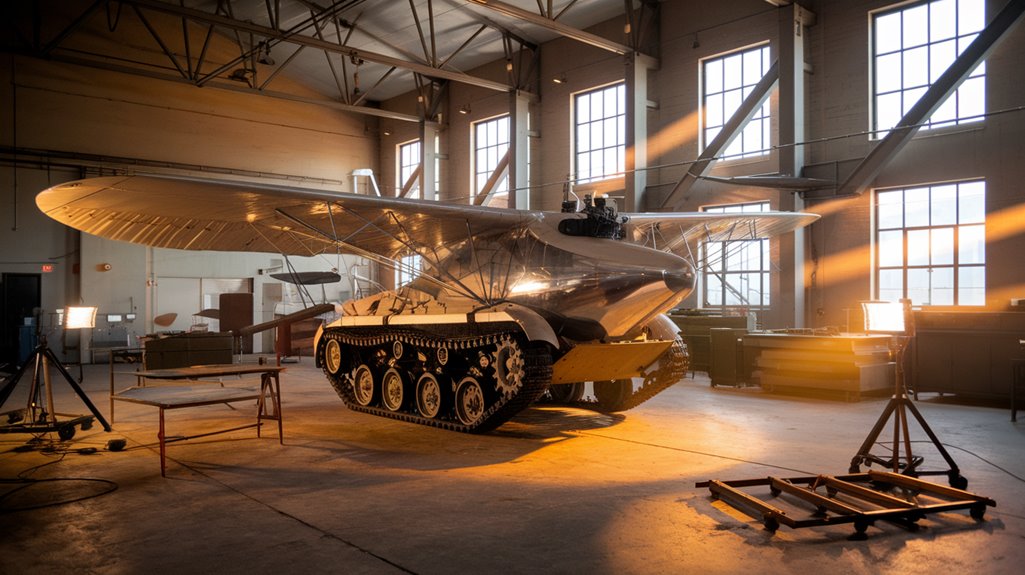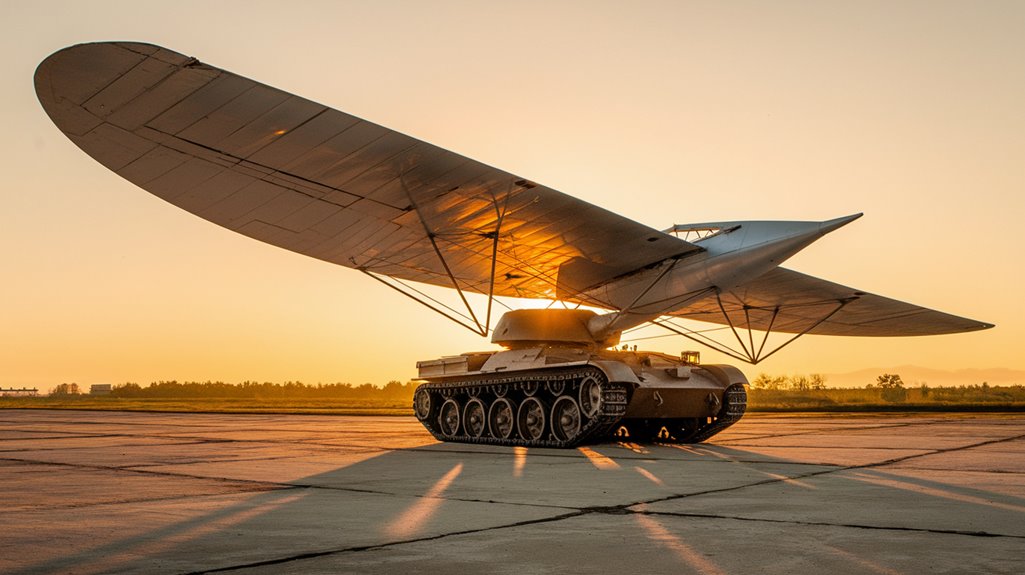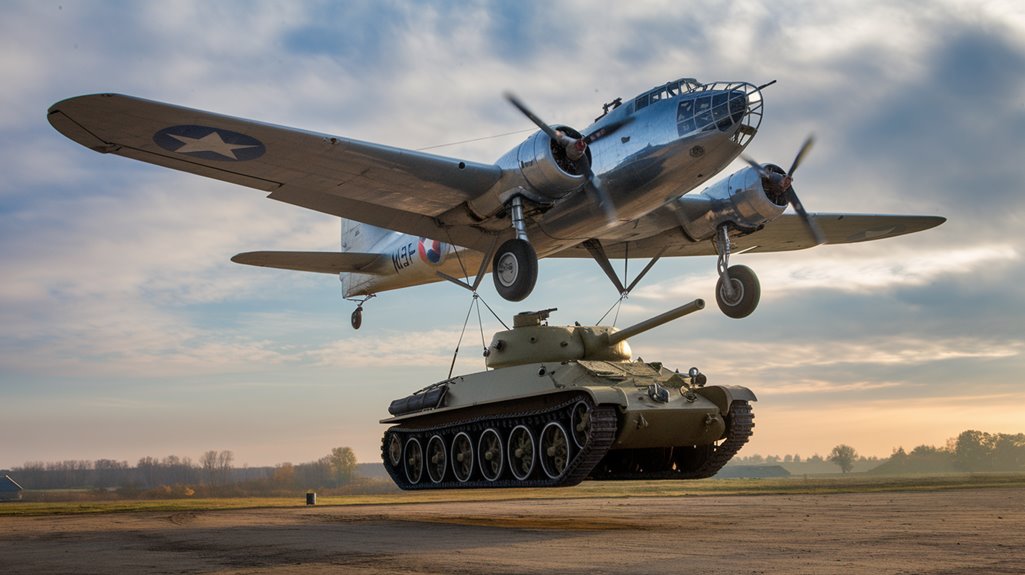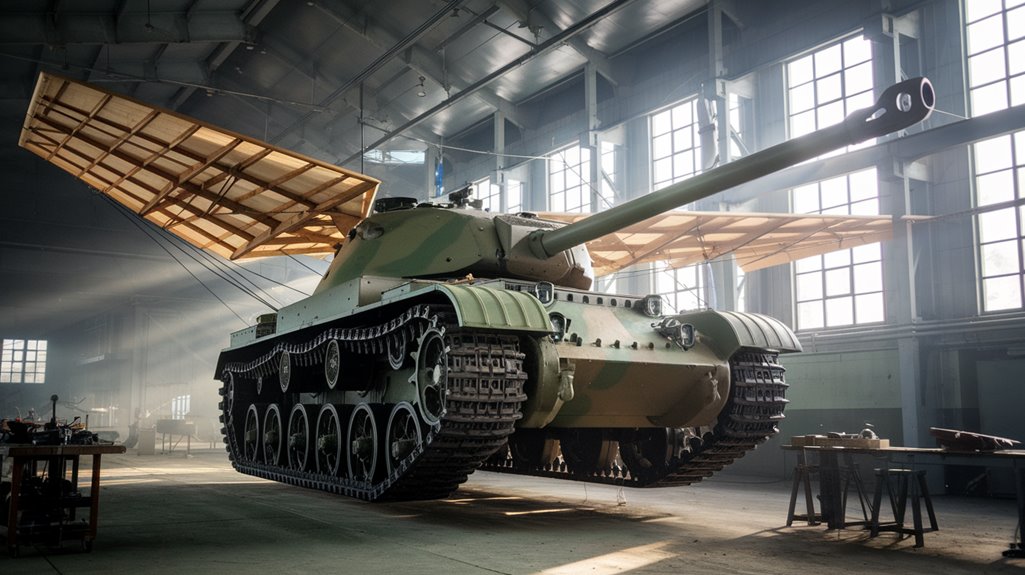The Flying Tank: A Real WWII Proposal
You've probably heard of tanks and planes, but have you ever imagined combining them? During World War II, Soviet engineers did exactly that with the Antonov A-40, also known as the flying tank. While it might sound like something from a child's imagination, this ambitious project wasn't just a wild dream – it was a real military prototype that made it off the drawing board and into the sky. The story behind this remarkable creation reveals both the ingenuity and limitations of wartime innovation.
The Birth of an Unconventional Idea

While many WWII innovations pushed technological boundaries, none were quite as audacious as the Soviet Union's flying tank concept.
Under intense wartime pressure, military necessity drove the Soviets to explore this unorthodox innovation as a solution to their tank deployment challenges. Like modern viral content that needs over 800 shares to gain significant traction, this unusual project needed substantial support to move forward.
You might think it sounds like science fiction, but the concept emerged from a real strategic need. The Soviets needed to transport tanks quickly to battle zones, as existing methods were too slow and dangerous.
They turned to aircraft designer Oleg Konstantinovich Antonov, tasking him with an unprecedented challenge: create a tank that could fly. The goal wasn't just to transport tanks – it was to transform them into gliding weapons that could swiftly enter combat zones and surprise enemy forces. This concept came at a time when the Soviets were already revolutionizing air warfare with their heavily armored Il-2 aircraft, proving they weren't afraid to experiment with unconventional military designs.
Engineering Behind the Antonov A-40
An engineering marvel of its time, the Antonov A-40 combined a T-60 light tank with a biplane glider configuration to create history's first flying tank.
The glider mechanics relied on a sophisticated cradle system that balanced weight distribution between the tank and the biplane structure, featuring N-type struts and support cabling. The tank's pilot served as the aircraft operator during flight operations. The initial test flight in September 1942 demonstrated both the concept's potential and limitations.
You'd be amazed by these key design elements:
- A 59.1-foot wingspan that generated enough lift to carry the 17,205-pound maximum takeoff weight
- A detachable wing system that could be jettisoned upon landing for rapid combat deployment
- An innovative setup where the tank's tracks could be powered before touchdown to guarantee immediate battlefield readiness
Despite its ingenious design, the A-40's weight and drag proved too challenging for the TB-3 bomber to maintain proper towing speed.
From Blueprint to Reality: Building the Flying Tank
Determined to revolutionize tank deployment, Soviet engineers undertook the ambitious task of transforming a T-60 light tank into the world's first flying tank in 1942.
Under Oleg Antonov's direction, they tackled significant design challenges by stripping the tank of non-essential components, including armament, ammunition, and headlights.
This remarkable feat of military innovation involved fitting the tank with custom-designed wooden and fabric biplane wings spanning 18 meters, along with a twin tail assembly.
Test pilot Sergei Anokhin was carefully selected to conduct the historic flight experiment.
You'd be amazed to learn that the wings were specifically engineered to be detachable, allowing the tank to quickly switch from aircraft to combat vehicle upon landing.
The modified T-60 was prepared for towing by either a Pe-8 or TB-3 aircraft, though ultimately only one prototype was ever constructed for testing. The project ultimately failed when the test flight revealed that even the most powerful aircraft available to the Red Air Force struggled to effectively tow the A-40.
The First and Final Flight
On September 2, 1942, test pilot Sergey Anokhin climbed into the world's first flying tank for its historic maiden flight. This experimental design, a T-60 light tank fitted with wooden wings and a fabric tail, was towed behind a TB-3 heavy bomber. The project was inspired by the Soviet Union's successful development of the Flying Tank Il-2, which had already proven its worth in combat.
You'd be amazed to learn that the tank's crew could control their flight using cables attached to the ailerons and flaps from the driver's seat. The tank reached a maximum altitude of only 131 feet before having to land.
Picture this unique piece of military aviation history:
- A massive tank suspended in mid-air, its biplane wings stretching wide
- The tank's turret turned backward against the wind
- The TB-3 bomber straining to tow its 17,205-pound payload through the sky
Despite the ingenuity behind this innovative concept, the extreme weight of the A-40 prevented it from becoming a practical weapon, and the project ended in 1943.
Why the Flying Tank Failed

While the flying tank project demonstrated remarkable creativity, multiple critical flaws doomed it from the start.
The major design flaws included wooden wings that couldn't handle the drag at speeds over 160 kph, causing dangerous control issues that forced the test pilot to jettison them mid-flight. The initial test flight on September 2, 1942 would be its only attempt.
The tactical shortcomings were equally severe.
You'd have to remove the tank's ammunition and fuel before flight, making it combat-ineffective upon landing. The T-60's thin armor and small 20mm cannon weren't a match for German tanks anyway.
Even if you'd solved these problems, there weren't enough suitable aircraft to tow the A-40s – only 80 PE-8 bombers were available.
The TB-3 bomber used in testing nearly failed from overheating, proving the concept wasn't practically viable.
Legacy and Lessons From the A-40 Project
Despite its ultimate failure, the A-40 flying tank project left an enduring legacy on military aviation and transport development.
You'll find its influence in modern military logistics and airborne warfare strategies, particularly in how we approach the challenge of deploying heavy equipment by air. The project's emphasis on using light tank designs aligned with the late 1930s concept of swift airborne insertion of combat vehicles. The successful test flight in 1942 proved that a stripped-down T-60 could actually glide and land safely.
The project taught valuable lessons that continue to shape military innovation:
- The need to carefully match aircraft capabilities with payload requirements
- The importance of rapid prototyping in developing new military technologies
- The potential for unconventional solutions in overcoming battlefield challenges
While you won't see flying tanks in today's military, the A-40's pioneering spirit lives on in modern air transport systems and combat vehicle deployment methods.











